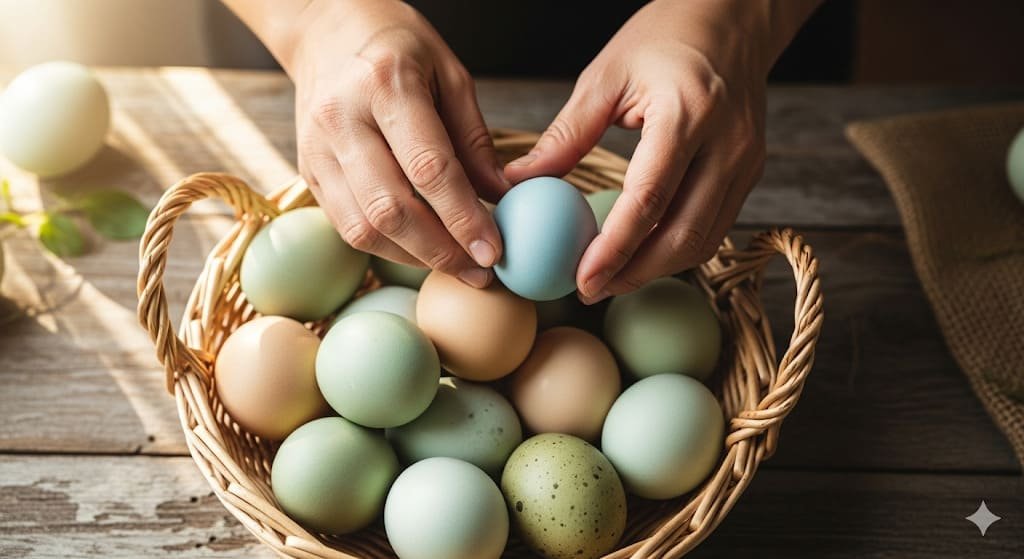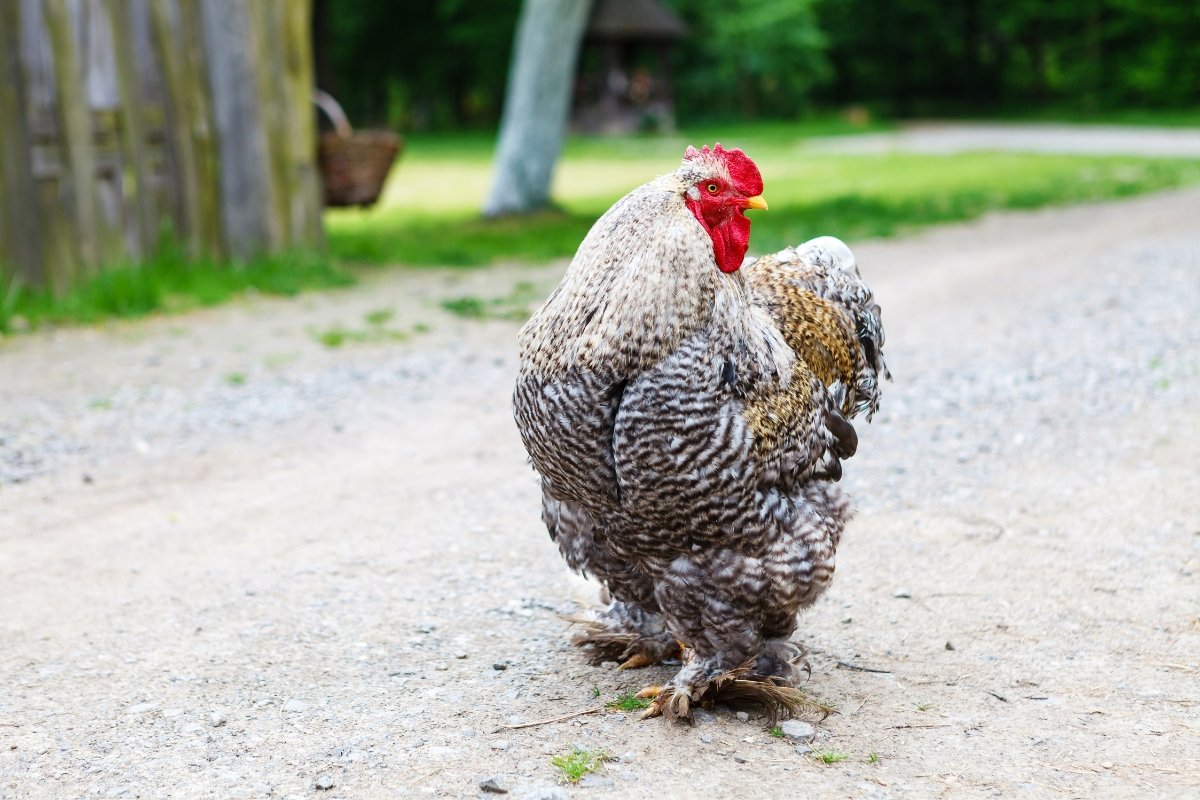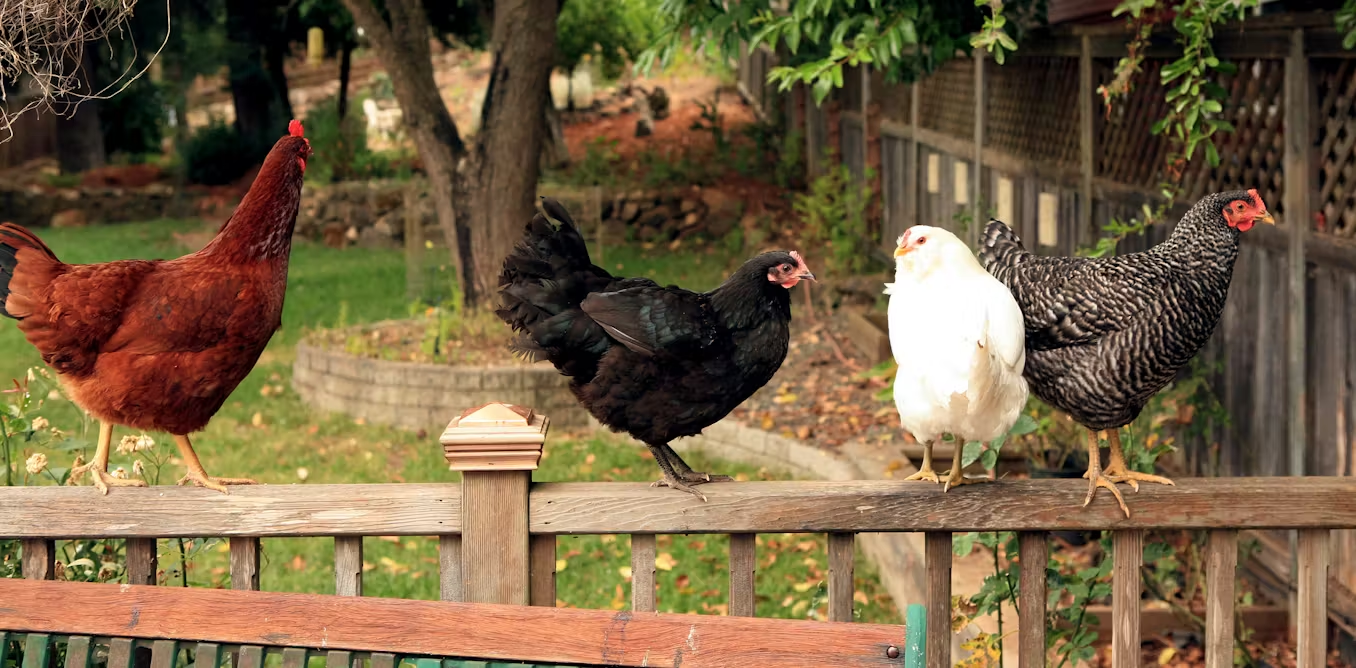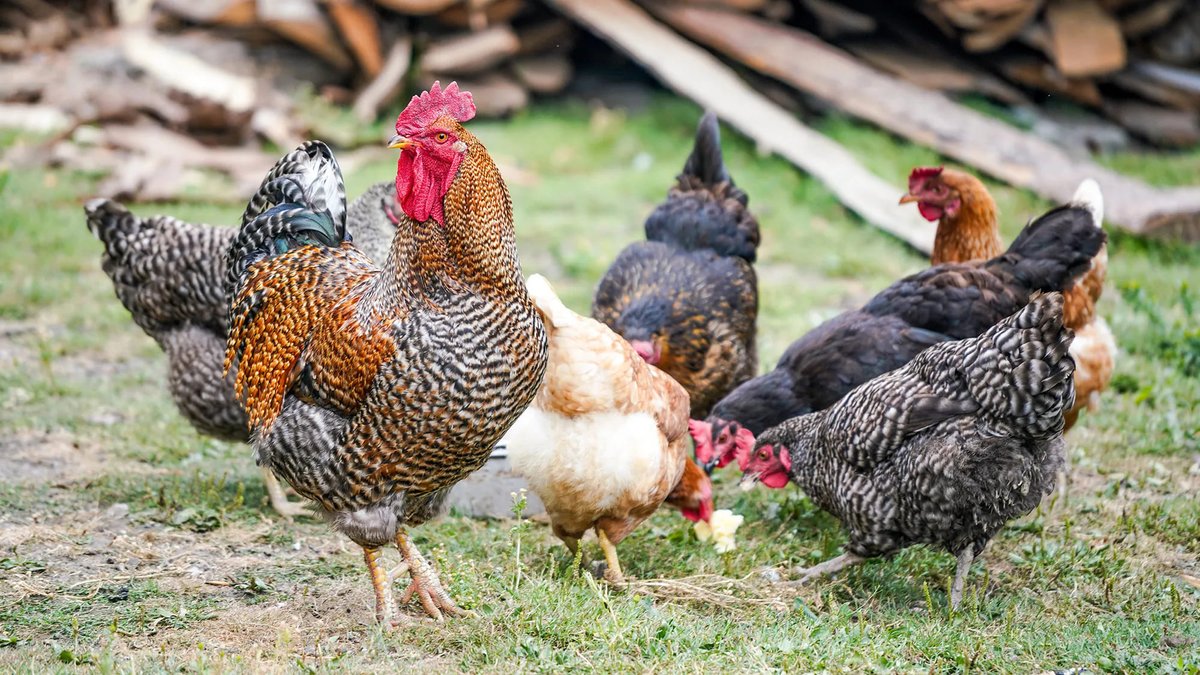As a backyard chicken keeper, few moments are as exciting as opening the nesting box to a basket of eggs in every shade of the rainbow. If you’ve ever found yourself asking, “What is an Easter Egger chicken?”, you’re likely drawn to the same joy of colorful egg layers that has made this bird so incredibly popular.
These friendly birds are the quintessential backyard chickens that bring a touch of whimsy and personality to any flock. They offer a constant surprise in your egg basket variety with shades of blue, green, pink, and even olive.
This guide will walk you through everything you need to know about this quirky, wonderful Easter Egger chicken, from its surprising genetics to its unique personalities and care needs. I can tell you from my own experience, starting with my first Easter Egger flock in late 2022, that these hens are the true gems of the flock.
Quick Facts
| Attribute | Details |
|---|---|
| Purpose | Primarily for egg production, also considered a dual-purpose breed. |
| Temperament | Docile, friendly, curious, and active. Excellent for beginners and families. |
| Egg Color | A variety of colors including shades of blue, green, olive, pink, and tan. |
| Egg Size | Medium to Large. |
| Production | 200-280 eggs per year (approximately 4-5 per week). |
| Hardiness | Hardy and adaptable to a wide range of climates, both cold and hot. |
Medical/Health Disclaimers:
The information provided in this guide is for educational and informational purposes only and is not intended to be a substitute for professional veterinary advice, diagnosis, or treatment. Always seek the advice of your veterinarian or other qualified animal health provider with any questions you may have regarding a medical condition for your flock. Never disregard professional veterinary advice or delay in seeking it because of something you have read in this guide.
What Are Easter Egger Chickens?
Understanding the Easter Egger Chicken Breed
Origins and Genetics
The Easter Egger chicken is a fascinating example of poultry genetics. These birds are a cross between any chicken that carries the blue egg gene (oocyanin) and another chicken of any other breed.
The most common parent breeds are the Araucana and Ameraucana, both of which possess the gene for blue eggs. According to The Happy Chicken Coop, these are the most common parent breeds (Source).
Because they are a hybrid and not a purebred, the Easter Egger chicken breed is not recognized by the American Poultry Association as a specific breed (Source). This means there is no breed standard, which is why their appearance and feather colors can be so wonderfully unpredictable.
The question, “What two breeds make an Easter Egger chicken?”, doesn’t have a single answer, but it’s most often a cross involving an Araucana or Ameraucana. These hybrid chickens benefit from a concept called “hybrid vigor,” which often makes them more robust and healthy than some purebreds.
This genetic diversity reduces the likelihood of inheriting breed-specific health issues and can result in higher fertility, better disease resistance, and overall hardiness.
Ameraucana vs. Easter Egger Chicken
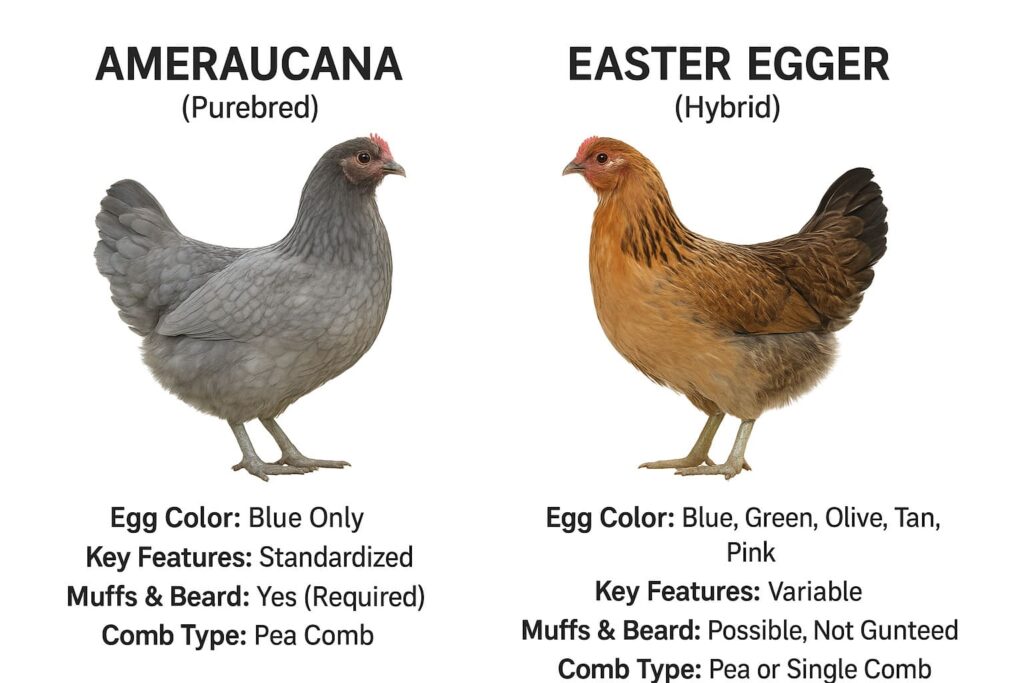
Understanding the difference between these two breeds is key to grasping the Easter Egger’s unique identity. As poultry enthusiasts often note, “Ameraucana Easter Egger chickens are a delightful mutt,” and that’s precisely what makes them so special.
An Ameraucana is a purebred chicken, recognized by the American Poultry Association for its specific physical traits and a consistent blue egg. Easter Eggers, in contrast, are a hybrid that may or may not inherit these specific traits, making each chicken a unique surprise.
| Feature | Easter Egger | Ameraucana | Araucana |
|---|---|---|---|
| Breed Status | Hybrid Cross | Recognized Breed | Recognized Breed |
| Egg Color | Blue, green, pink, olive, tan | Blue | Blue |
| Genetics | Carries the blue egg gene | Purebred with blue egg gene | Purebred with blue egg gene |
| Physical Traits | Highly varied, “fluffy muffs” & “beards” common, but not guaranteed | “Muffs” and “beards” | “Ear tufts,” rumpless |
| Origin | Modern Hybrid | Developed in the U.S. | Developed in Chile |
The primary difference, and a frequent question, is “What is the difference between an Easter Egger and Ameraucana?”. The Ameraucana is a purebred chicken, bred for specific physical traits like their muffs and beards, and a consistent blue egg.
The Araucana, a heritage breed, is known for its “rumpless” trait (no tail) and unique ear tufts, but also carries a lethal gene that makes breeding difficult. Easter Egger chickens, in contrast, are a hybrid that may or may not inherit these specific traits, making each chicken a unique surprise.
According to the team at My Pet Chicken, “The beautiful ‘fluffy muffs‘ and ‘beards‘ are dominant traits often passed down to Easter Eggers from their Ameraucana parents” (Source). The genetic combination is what produces the beautiful variety, but it also means no two Easter Egger chickens are exactly alike.
Easter Egger chickens are a delightful example of a hybrid that captures the best of both worlds: the unique egg color of their heritage parents with the added benefit of vigor and health. Their unpredictable nature is part of their charm, and this variety extends far beyond their genetics.
Easter Egger Chicken Colors and Appearance
Easter Egger Chicken Colors and Physical Characteristics
Feather Colors and Patterns
The beauty of the Easter Egger chicken lies in its unpredictability. There is no set standard for Easter Egger chicken colors, so you may see hens and roosters in a stunning array of shades.
It’s common to see them in black, buff, blue, brown, or white, with an incredible variety of patterns including spots, bars, or lacing. This lack of a breed standard is what makes them so much fun—you truly never know what you’ll get. A quick search for “Easter Egger chicken photos” will reveal the astonishing variety, with each bird a distinct and beautiful individual. These variations make it easy to tell your birds apart and give them a unique personality.
Distinctive Features
While their feather colors are a mystery, many Easter Egger chickens inherit a few key distinguishing features from their parent breeds. The most recognizable are the “cheek poufs and beards,” which give them a fluffy, endearing look.
These feathered tufts are a classic trait often associated with the Ameraucana breed. An average Easter Egger chicken will weigh between 4-6 pounds and have a sturdy, well-proportioned body. While some may inherit a smaller comb, others may have a larger one, and their legs can range in color from slate to yellow.
These unique traits are a big part of how to identify Easter Egger chickens. The unique “fluffy muffs” are often the most noticeable trait, setting them apart from other breeds.
Sexing Easter Egger Chicks
One of the most challenging aspects of raising Easter Egger chickens is determining their sex. Since they are hybrids, the traditional sex-link traits (which make it easy to tell a male from a female chick) do not apply.
This is why many hatcheries will have a “Straight Run” option, meaning you will get a mix of male and female chicks. If you need to identify the sex of your chicks, there are a few methods:
- Feather Sexing: At one day old, you can examine the length of the primary wing feathers. In some strains, females have longer feathers, while males have shorter ones.
- Vent Sexing: This is a method performed by professionals and is not recommended for beginners.
- Comb and Wattle Development: Roosters will typically develop a larger comb and wattle earlier than hens, and their legs will often be thicker. This becomes noticeable around 6-8 weeks of age.
The beauty of the Easter Egger chicken is truly in the eye of the beholder, as each one is a one-of-a-kind creation. This unpredictability in appearance only adds to the excitement of finding out what beautiful color egg they will lay.
The Rainbow of Easter Egger Chicken Eggs Colors
Easter Egger Chicken Egg Colors Explained
What Color Eggs Will My Easter Egger Lay?
The most exciting aspect of raising these birds is the promise of Easter Egger chicken eggs colors. It’s the primary reason they have become a staple of backyard flocks.
Once a hen begins laying, she will produce a consistent color egg throughout her life, but that color can be almost anything. The possibilities include blue, green, olive, pink, and tan. This is why they are often called colorful egg layers or green egg layers.
The question, “What color eggs will my Easter Egger lay?”, is one of the most common, but the answer is a surprise until that first egg drops. I’ll never forget the day my first Easter Egger chicken, a little puffball named Pip, surprised me with her inaugural egg in the spring of 2023. While I was hoping for a bold blue, she dropped a beautiful speckled olive green one instead.
It’s important to note that a single hen will not lay multiple colors—each one is a one-woman show, committed to a single, beautiful shade.
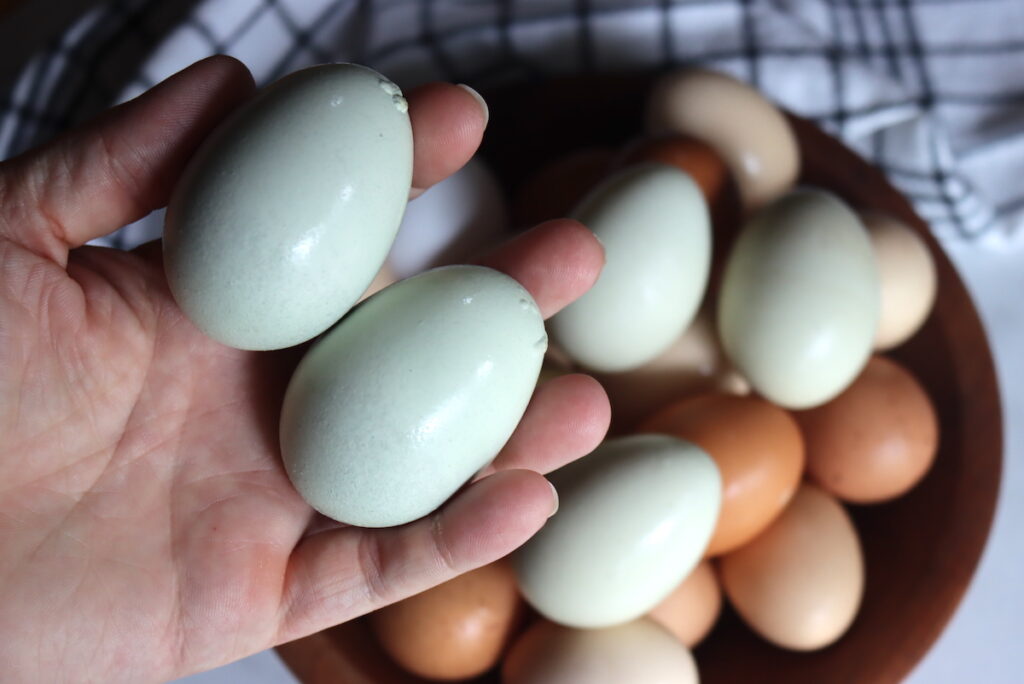
The Science Behind Colorful Eggs
The secret behind the “rainbow egg basket” is a combination of genetics and fascinating biology. The blue color is due to the presence of the blue egg gene (OO), a pigment that is deposited on the egg shell early in its formation.
Unlike brown eggs, where the pigment is applied late and only on the shell’s exterior, oocyanin penetrates the entire shell, so the inside of the shell is also blue. This egg shell pigmentation is unique because it penetrates the entire shell, which is why blue eggs are blue on the inside and outside.
Green or olive eggs are created when a hen with the oocyanin gene also carries a gene for brown pigment (protoporphyrin). The brown pigment is applied on top of the blue, creating a beautiful green or olive hue.
This is supported by a study in the National Center for Biotechnology Information (NCBI) on poultry genetics (Source). It’s also a common misconception that certain nutrients or diet will change the color of the eggs—this is a myth; genetics are the sole determinant of egg color.
According to the Chicken Coop Company, “The truth is simple: the only real difference between colored and white/brown eggs is the shell color. Egg color is determined by a hen’s genetics” (Source).
The Difference Between Easter Eggers and Olive Eggers
While both types of blue egg chickens lay colorful eggs, an Olive Egger is a specific cross that is bred to produce a deep olive-green egg. This is typically achieved by breeding a blue egg layer (like an Ameraucana) with a dark brown egg layer (like a Marans).
The resulting chicks are almost guaranteed to lay olive eggs. According to Purina Mills, this is how you achieve the olive egg color (Source).
In contrast, an Easter Egger chicken is a more general hybrid that can lay any color from the blue/green/brown spectrum, so you may get a blue, green, or even a tan egg from a single Easter Egger chicken. If you are specifically looking for olive-green eggs, an Olive Egger might be a better choice for you.
Factors Affecting Egg Color Intensity
While genetics determine the color, several factors can influence the intensity of the pigment. A hen’s first few eggs may be more vibrant, and the color can fade slightly as she continues to lay.
Stress, diet changes, and health issues can also cause the color to become less saturated. The Penn State Extension explains why eggs can lose color (Source).
Ensuring your hen has a low-stress environment and a high-quality diet will help her lay the most vibrant eggs possible. For hens laying olive or green eggs, the color can vary from a light sage to a deep olive depending on the concentration of the brown pigment.
The anticipation of that first egg is a core part of the Easter Egger experience. And once you know your hen’s unique color, you can look forward to a steady supply of fresh, beautiful eggs.
Breeding Easter Eggers: The Art and Science of Colorful Eggs
Breeding your own Easter Egger chickens is a rewarding experience that allows you to play with genetics and create a new generation of colorful egg layers. Since the Easter Egger chicken is not a purebred, the goal of breeding them is to ensure the blue egg gene (OO) is passed down while also introducing other pigments to create new colors.
Understanding the basics of how egg color is inherited can help you predict the outcome of your crosses. The most important factor is the presence of the dominant blue egg gene. The blue egg gene is a dominant gene, meaning a chicken only needs one copy of the gene to lay a blue egg. A hen with the blue egg gene (OO) will lay a blue egg, while a hen without it (oo) will lay a white or brown egg. The brown pigment gene is then layered on top of the blue pigment, resulting in a green or olive egg.
Here is a simplified chart to help you predict the egg colors of the offspring from common crosses.
Breeding for Color: Egg Prediction Chart
| Parent 1 | Parent 2 | Likely Egg Color of Offspring | Genetic Explanation |
|---|---|---|---|
| Blue Egg Layer<br>(e.g., Ameraucana, Easter Egger) | White Egg Layer<br>(e.g., White Leghorn, Ancona) | Blue | The blue gene is dominant. A white egg layer has no pigment to apply over the blue, so the egg remains a clear, beautiful blue. |
| Blue Egg Layer<br>(e.g., Ameraucana, Easter Egger) | Brown Egg Layer<br>(e.g., Marans, Welsummer, Rhode Island Red) | Green or Olive | The offspring will inherit the dominant blue gene from the blue egg layer and the brown pigment gene from the brown egg layer. The brown pigment is applied over the blue, resulting in a green or olive egg. |
| Blue Egg Layer<br>(e.g., Ameraucana, Easter Egger) | Light Brown Egg Layer<br>(e.g., Rhode Island Red, Plymouth Rock) | Green or Tan | The blue gene mixes with a lighter brown pigment, resulting in a lighter green or sometimes even a tan egg, depending on the amount of brown pigment. |
| Green Egg Layer<br>(e.g., Olive Egger, Easter Egger) | Green Egg Layer<br>(e.g., Olive Egger, Easter Egger) | Green, Olive, Brown, or Blue | The outcome is a mix. The offspring can inherit any combination of the blue and brown genes. You might get a green or olive egg, a pure brown egg (if the hen doesn’t inherit the blue gene), or a pure blue egg (if she doesn’t inherit the brown pigment). |
Breeding chickens is a fun and educational experience that adds another dimension to the backyard chicken hobby.
Easter Egger Chicken Egg Production
Are Easter Eggers Good Egg Layers?
How Many Eggs Do Easter Egger Hens Lay a Year?
Yes, they are! In fact, the Easter Egger chicken egg production is one of their most popular traits.
A healthy Easter Egger chicken can typically lay between 200 and 280 eggs annually, which averages out to 4-5 eggs per week. While this range is common, some may produce fewer eggs depending on their specific genetics and environmental factors. My Pet Chicken suggests that this range is common (Source).
This makes them a highly productive and efficient choice for your backyard flock. I know from keeping meticulous records that my flock of 6 Easter Eggers, over the course of three years from 2022 to 2025, averaged a remarkable 247 eggs per bird annually.
Can Easter Eggers Lay Two Eggs a Day?
This is a common question, and the answer is almost always no. The reproductive process of a hen is a complex biological cycle.
From the time a yolk is released until a fully formed egg is laid, the process takes approximately 24 to 26 hours. This timeframe makes it biologically impossible for a hen to lay two eggs in a single 24-hour period under normal circumstances.
While a hen may occasionally lay two eggs within a calendar day (one late at night and one early the next morning), it’s not a sustainable pattern and is not a sign of a hen “doubling” her production.
Egg Laying Timeline and Maximizing Production
Most Easter Eggers begin laying between 20-24 weeks (approximately 5-6 months), though some may start as early as 19 weeks or as late as 28 weeks. This can vary based on the season they hatch, their diet, and overall health.
Factors that affect Easter Egger chicken egg production include changes in lighting, stress, molting, and their age. A common question is “Why do Easter Eggers stop laying eggs?” and the answer is that it’s a natural part of their life cycle.
Oklahoma State University Extension notes that hens will slow or stop egg production during the winter months when there is less sunlight, and during their annual molt (Source). Their production will also naturally decline as they get older, but a well-cared for hen will continue to lay for many years.
One interesting observation is that a sudden warm front in the middle of winter can sometimes trigger a brief period of increased laying, even if the days are short.
To get the most eggs from your hens:
- Provide Consistent Light: In northern climates, providing supplemental light in the coop during the short winter days can maintain production. Use a timer to give them 14-16 hours of light per day.
- Offer a Balanced Diet: A high-quality layer feed is essential. Ensure they have a consistent supply of food and fresh water.
- Reduce Stress: A clean, safe, and calm environment will help your hens feel secure and lay more consistently.
Consistent, reliable egg production is a hallmark of the Easter Egger chicken. This productivity, combined with their calm and friendly disposition, is what makes them a favorite for new and experienced chicken keepers alike.
Easter Egger Chicken Temperament and Behavior
Are Easter Egger Chickens Good for Beginners?
The short answer is absolutely yes! One of the most endearing qualities of the Easter Egger chicken is its docile and friendly temperament, making them perfect for those new to keeping chickens.
They are known for being curious, active, and gentle, often following their owners around the yard. Country Living magazine notes that they are a great choice for families with children (Source).
Their friendly disposition makes them a great choice for families with children, and my own flock has always included an Easter Egger chicken to bring a touch of that “cottagecore eggs” aesthetic and a ton of personality to the flock.
My most inquisitive Easter Egger chicken, named Henna, would often follow me around the garden and, in July 2025, she learned to lightly peck at my shoelaces until I picked her up.
A contributor to the popular homesteading forum Permies summed it up perfectly, writing, “If I could only have one kind of chicken, this would probably be it. Easter Egger chickens are gentle, nice birds that do well in a mixed flock” (Source).
Noise Levels and Urban Suitability
Compared to many other poultry breeds, Easter Egger chickens are not particularly noisy, making them a good option for suburban settings. While hens will still cluck and announce a laid egg, they are generally not as loud as some other breeds.
Their calm nature means they are less likely to cause a ruckus. Their peaceful demeanor also makes them a favorite among keepers who prefer a quieter backyard flock.
Flock Dynamics and Social Behavior
Easter Egger chickens generally integrate well into a mixed flock. Their placid nature means they are typically not at the top of the pecking order, but they are also not at the very bottom.
They are active foragers and will happily spend their days scratching for bugs and grass in the yard. Their friendly disposition means they are less likely to be aggressive towards other birds, making them an excellent choice for a diverse flock.
When introducing new birds, a gradual approach is key to minimize stress and prevent pecking. For more help with your flock’s social structure, check out our guide on pecking order problems.
A Note on Easter Egger Roosters
Easter Egger chicken roosters are just as varied as their hen counterparts. They can be incredibly gentle and protective, or they can be prone to aggression depending on their genetics and upbringing.
Generally, they are less aggressive than roosters from more flighty breeds, but their chicken temperament can be a coin toss. It is important to handle rooster chicks frequently to encourage a friendly disposition.
The friendly and docile nature of the Easter Egger chicken makes them a joy to have in the backyard. Their ability to get along with others ensures a harmonious and happy flock.
Complete Care Guide
How to Care for Easter Egger Chickens
Housing Requirements
Easter Egger chickens are known for being a very hardy and adaptable breed, well-suited to both cold and heat. As Tractor Supply Co. points out, they are a breed that reduces heat stress risk (Source). To ensure their safety and health, follow these steps:
- Build a Secure Coop: The coop must be secure from predators and well-ventilated to prevent moisture buildup and respiratory issues. Ensure there are no gaps or holes where predators can enter.
- Provide Ample Space: Plan for at least 4 square feet of space per chicken inside the coop and 10 square feet in the run. Overcrowding can lead to stress and health problems.
- Install Nesting Boxes: Provide a comfortable nesting box with clean bedding for every 3-4 hens. This encourages them to lay in designated areas. The boxes should be placed in a quiet, dark spot away from the main roosting area.
- Consider Roosts: Chickens need a place to roost at night. Install roosting bars higher than the nesting boxes. A round or flat roosting bar about 2 inches in diameter is ideal for their feet.
Feeding Easter Egger Chickens
Feeding your Easter Egger chickens a proper diet is crucial for their health and egg production. A balanced diet ensures they have all the nutrients they need to thrive.
- Weeks 1-8 (Chick Starter): For chicks, start them on a high-protein starter feed (21%) for the first eight weeks. This provides the essential nutrients for rapid growth.
- Weeks 9-18 (Grower Feed): Switch to a grower feed (18%) until they are ready to lay their first egg. This diet supports their continued development without being too high in calcium.
- Week 18+ (Layer Feed): Once they begin laying, transition them to a quality layer feed (16%). This provides the necessary calcium and protein for consistent egg production. Purina Mills’ chicken feeding guide outlines these stages of growth (Source).
- Provide Supplements: Supplement their diet with oyster shell to ensure strong eggshells. You can offer this in a separate dish, allowing the hens to take what they need.
- Offer Fresh Water: Always ensure they have access to fresh, clean water.
Health Considerations
Easter Egger chickens are generally a healthy breed with a lifespan of 5-8 years. They are susceptible to common poultry ailments like mites and lice, so regular checks are necessary.
According to the University of Minnesota’s College of Veterinary Medicine, these ailments are common in backyard poultry (Source). A unique health concern for some Easter Egger chickens, inherited from their parent Araucana breed, is a susceptibility to “scissor beak“, a condition where the top and bottom of the beak do not align. While it’s not common, it’s something to be aware of when you bring them into your flock. Always consult a veterinarian for a proper diagnosis and treatment plan for any health issues.
To keep your flock healthy, provide a dust bath area and a clean coop to prevent parasites. Watch for signs of illness like lethargy, ruffled feathers, pale comb, or a lack of appetite.
As Hatching Time points out, “Breed Selection: Choosing heat-tolerant breeds like Rhode Island Reds, Leghorns, and Easter Egger chickens reduces heat stress risk” (Source). This confirms their hardiness and ability to thrive in a range of climates.
Proper care is the foundation of a happy and healthy flock. By following these guidelines, you can ensure your Easter Egger chickens thrive and provide you with beautiful eggs for years to come.
Seasonal Care Guide
Winter Egg Production and Lighting Requirements
It’s a common observation among backyard chicken keepers that hens, including Easter Egger chickens, often cease laying during the winter months. This isn’t because they are sick or too cold; it’s a natural biological response to the decrease in daylight hours.
A hen’s reproductive system is triggered by light, and they require a minimum of 14-16 hours of light per day to maintain consistent egg production. When the days get shorter, their laying cycle slows or stops completely.
For keepers who want to maintain a steady supply of eggs throughout the winter, providing a supplemental light source in the coop is the most effective solution. A simple 25 to 40-watt bulb on a timer, set to come on in the morning before dawn, can provide the extra hours of light needed to “trick” your hens into continuing their laying cycle.
It’s important to keep the light on a timer and provide a consistent schedule to avoid stressing the birds.
It’s also worth noting that a warm front in the middle of winter can sometimes trigger a brief period of increased laying, even without supplemental lighting. This is a temporary response to the change in temperature and is not a sign that they will resume full-time production. The most reliable way to get those colorful eggs year-round is through a consistent lighting schedule.
Monthly Care Calendar
A consistent care routine is key to a healthy flock. Here is a simple calendar to help you keep track of your most important seasonal tasks.
Spring
- Coop Deep Clean: Do a thorough cleaning of the coop to remove all old bedding and sanitize surfaces.
- Pest Check: Inspect your hens for any signs of mites or lice as the weather warms up.
- Introduce New Birds: Spring is the best time to introduce new chicks or hens to the flock.
Summer
- Heat Management: Ensure your chickens have plenty of shade and fresh, cool water. You can freeze treats like berries in water for a cool snack.
- Monitor Water: Check waterers multiple times a day as chickens can get dehydrated quickly in the heat.
- Cleanliness: Regularly spot clean the coop to keep odors and pests at bay.
Fall
- Molt Support: Your hens will likely begin their annual molt. Provide a higher protein feed (18% protein) to help them regrow their feathers.
- Coop Winterization: Inspect the coop for any drafts or leaks and make necessary repairs.
- Predator Prep: Be extra vigilant as predators may be more active seeking food before winter.
Easter Egger Chicken Health Issues and Solutions
Even with the best care, you may run into a few common issues with your Easter Egger chicken flock. Here are some solutions to help you troubleshoot:
Troubleshooting Checklist: When Hens Stop Laying
If your hen’s Easter Egger chicken egg production has suddenly dropped or stopped, consider these factors in a systematic order:
- Is she old enough? Hens don’t start laying until 5-6 months old.
- Is she too old? Production naturally declines after the first 2-3 years.
- Is it molting season? Most hens stop laying during their annual molt to redirect energy to feather regrowth.
- Is there enough daylight? Chickens require 14-16 hours of daylight to maintain production. This is the most common reason for a laying pause in winter.
- Is she stressed or being bullied? Stressors like a new predator, overcrowding, or bullying can cause a hen to stop laying. Look for bald spots on the back of her neck or back.
- Is her diet balanced? Ensure she’s eating a high-quality layer feed with enough calcium for strong shells.
- Is she sick? Check her for signs of illness, such as lethargy, ruffled feathers, pale comb, or a lack of appetite.
Stress and Bullying
Stress is a major factor that can cause a hen to stop laying, and bullying is one of the most common causes of stress in a flock. A hen that is being bullied may be prevented from eating, drinking, or even accessing the nesting boxes, which can halt her egg production.
Look for signs of bullying like missing feathers on the back of the neck or head, or a hen that appears to be avoiding the rest of the flock. To manage this:
- Isolate the Bully: If you can identify the aggressor, it’s often best to remove them from the flock for a few days to reset the pecking order.
- Provide More Space: Overcrowding is a major cause of bullying. Ensure your flock has enough space to forage and escape from each other.
- Add More Resources: Provide multiple feeders and waterers so that all hens can access food and water without competition.
Dealing with Pests: Mites and Lice
Mites and lice are common in backyard chickens and can cause stress, feather loss, and decreased egg production. I learned this the hard way when my entire flock was infested in the summer of 2023.
I first noticed the issue when one of my hens, a buff Easter Egger named Goldie, was lethargic, had a pale comb, and was losing feathers around her vent. After a close inspection, I could see tiny mites crawling on her skin. The Spruce notes that these are common parasites (Source).
My solution was a multi-step process: I first dusted every bird with a poultry-safe mite powder, then I completely cleaned out the coop, and finally, I dusted all the bedding, roosts, and nesting boxes with diatomaceous earth. Within a week, the mites were gone, and Goldie was back to her feisty self.
Broodiness
An Easter Egger chicken may occasionally go broody, meaning she wants to sit on eggs to hatch them. I’ve had a few hens go through this phase, and it’s best to handle it quickly to get them back to laying.
- Identify Broodiness: A broody hen will stay in the nesting box all day, puff out her feathers, and make a distinct clucking sound.
- Break the Cycle: To stop her from being broody, you can do this by removing her from the nesting box a few times a day, placing her in a “broody breaker” cage for a day or two, or blocking her access to the nesting box. According to Backyard Poultry magazine, this can help stop the cycle (Source). For more detailed instructions on broody behavior, see our guide on how to break a broody hen.
Soft-Shelled or Strange Eggs
Early in my chicken keeping journey, I discovered this the hard way when I found a soft-shelled egg. If you’re finding eggs with very thin, soft, or no shells, it’s a sign of a calcium deficiency.
The Chicken Whisperer explains that a lack of calcium can cause this issue (Source).
- Provide Oyster Shell: Ensure you have a separate dish of oyster shell available at all times. The hens will self-regulate and eat what they need.
- Check Feed: Make sure you are using a proper layer feed (16% protein) and not a grower or all-purpose feed.
Knowing how to handle these common issues will help you maintain a healthy and productive flock. A prepared keeper is a successful keeper.
Pros and Cons Analysis
What Are the Pros and Cons of Easter Egger Chickens?
Advantages
The list of advantages for raising Easter Egger chickens is long, which is why they are so popular. They offer a unique colorful egg variety, which adds charm and beauty to any egg basket.
Their excellent egg production makes them a practical choice for backyard keepers. They are hardy and adaptable to various climates, and their friendly temperament and low broodiness tendency make them a joy to have in the flock.
Finally, their unique appearance variety, with all the different feather and face colors, means you will have a truly one-of-a-kind bird.
Disadvantages
The primary disadvantage is that the Easter Egger chicken breed is not a standardized breed. This means you can’t show them, and their appearance will be unpredictable.
Likewise, the egg color unpredictability per bird means you won’t know exactly what color you’ll get until they start laying, which might be a dealbreaker for someone looking for a specific color.
Breeding and Dual Purpose Considerations
Easter Egger Dual Purpose: A Closer Look
While an Easter Egger chicken can be used for meat production, they are primarily valued for their egg-laying capabilities. This makes them a great backyard chicken, but not a true “dual-purpose” bird in the traditional sense. Here’s a quick breakdown:
- Egg Production: As an egg-laying chicken and the Easter Egger is a superstar. Their high production rate of 200-280 eggs per year makes them a top choice for a steady supply of fresh eggs. This is their main purpose.
- Meat Production: As a meat bird, the Easter Egger is decent but not exceptional. They typically weigh between 4-5 pounds, which is not as substantial as breeds specifically bred for meat like the Cornish Cross or even a heavier heritage breed like the Wyandotte or Plymouth Rock. While the meat quality is excellent, you’ll get a smaller yield.
For this reason, they are considered a “dual-purpose” bird, but their biggest value to the backyard keeper will always be the Easter Egger chicken egg production.
Purchasing Guide
Easter Egger Chickens for Sale: Buying Guide
Easter Egger Chicken Price
The average Easter Egger chicken price is very affordable, often around $3.30 per chick, making them an accessible option for those new to keeping chickens. The price can vary based on the hatchery, breeder, and location, but they are generally less expensive than purebred chickens.
Cackle Hatchery offers them at this affordable price (Source).
Where to Find Easter Eggers
Finding Easter Egger chickens for sale is relatively easy. The most common places to find them are reputable hatcheries, local feed stores, and online poultry suppliers. Some of the most well-known hatcheries that carry Easter Eggers include:
- Murray McMurray Hatchery: A large, popular hatchery with a wide variety of breeds and a strong reputation.
- Cackle Hatchery: Known for its extensive selection of poultry breeds and long history in the industry.
- My Pet Chicken: An online retailer that specializes in smaller orders and provides a great deal of educational information.
When purchasing, look for healthy, active chicks, and consider the reputation of the source to ensure you are getting a quality bird.
Comparison Table: Easter Eggers vs. Other Colorful Egg Layers
| Feature | Easter Egger | Olive Egger | Marans |
|---|---|---|---|
| Egg Color | Blue, green, pink, olive, tan | Deep Olive Green | Dark Brown, often speckled |
| Breed Status | Hybrid Cross | Hybrid Cross | Recognized Breed |
| Temperament | Docile, curious, and friendly. Excellent for beginners and families. | Can be more reserved and shy, but generally calm. | Docile and gentle. Can be quite calm and easy to handle. |
| Annual Egg Production | 200 – 280 eggs | 180 – 220 eggs | 150 – 200 eggs |
| Price (per chick) | Very affordable ($3-$5) | More expensive than Easter Eggers ($5-$8) | Moderately expensive ($6-$10+) |
| Physical Traits | Highly varied, with muffs and beards common. | A wide variety of appearances, often with feathered legs and beards. | Distinctive feathered legs and feet. |
Frequently Asked Questions
Are Easter Eggers good for beginners?
Yes, due to their docile and friendly temperament, as well as their hardiness and excellent egg production, they are one of the best choices for beginner chicken keepers. You can also explore our article on the easiest chicken breed for beginners.
What chicken lays pink or purple eggs?
While many refer to pink or purple eggs, these are typically just a variation of a brown egg that can appear pinkish due to a brown pigment overlay. Easter Egger chickens do not lay true pink or purple eggs, but rather shades of brown, green, and blue.
Why do Easter Eggers stop laying eggs?
Hens will naturally slow down or stop laying eggs due to seasonal changes (less sunlight), molting (shedding and regrowing feathers), or old age. Ensuring they have proper nutrition and enough light can help maintain production.
Can chickens recognize their owners?
Yes! Chickens are intelligent creatures and can recognize their owners’ faces and voices, often associating them with food and safety. According to Purina Mills, chickens are smarter than you might think (Source). An Easter Egger chicken’s friendly nature makes this bond particularly strong.
What is the most expensive chicken breed?
The Ayam Cemani is one of the most expensive chicken breeds in the world, known for its all-black appearance, including feathers, bones, and organs.
What is the easiest chicken to keep?
Breeds like Easter Egger chickens, Orpingtons, and Plymouth Rocks are generally considered among the easiest to keep due to their calm temperaments, hardiness, and consistent egg production.
How to tell Easter Egger from Ameraucana chicks?
Telling them apart at a young age can be tricky, as Easter Egger chicks often inherit the distinctive beards and muffs from their Ameraucana parents. The biggest clue is that Ameraucanas are bred to a strict standard, so their feather and physical characteristics are predictable and consistent. Easter Eggers, being hybrids, can be much more variable in appearance, even within the same hatch. If you are not purchasing chicks from a breeder who can verify their purebred status, it’s best to assume they are Easter Eggers.
Do Easter Egger roosters crow loudly?
The volume of a rooster’s crow varies widely by individual personality, not just the breed. While some Easter Egger roosters may have a loud crow, they are not typically known for being as boisterous as some other breeds like the Leghorn. Most keepers find their crow to be manageable, but it’s always a good idea to consider your neighbors.
Can Easter Eggers fly over fences?
Yes, they can! Because they are a lighter, medium-sized breed, they are agile and can fly fairly well, especially if startled. They are capable of clearing low to medium fences (around 4-5 feet), so you may need to consider a taller fence or clip their wings to keep them contained in the coop and run.
Best companion breeds for Easter Eggers?
Due to their friendly and docile nature, Easter Eggers get along well with most other calm, non-aggressive breeds. Some of the best companions for them are docile breeds like Orpingtons, Plymouth Rocks, Wyandottes, or even other quiet breeds like Cochins. It’s best to avoid more assertive or flighty breeds that may bully them, such as Leghorns or game birds.
Is This Breed Right For You?
Ultimately, the Easter Egger chicken is a wonderful addition for anyone who wants a friendly, hardy, and productive layer with a surprise in every nest.
They are an excellent choice for first-time chicken owners and families, as their docile and friendly temperament makes them easy to handle.
While their egg color and physical appearance are a mystery until they mature, this unpredictability is part of their unique charm. If you’re looking for a low-maintenance, resilient Easter Egger chicken that brings a delightful variety of colors to your egg basket, this may just be the perfect bird for you.
Additional Resources
- Easter Egger Chicken & Blue Eggs | Everything You Need to Know – This video offers a comprehensive overview of Easter Egger chickens and their unique characteristics, which can be a valuable resource for aspiring chicken keepers.

Oladepo Babatunde is the founder of ChickenStarter.com. He is a backyard chicken keeper and educator who specializes in helping beginners raise healthy flocks, particularly in warm climates. His expertise comes from years of hands-on experience building coops, treating common chicken ailments, and solving flock management issues. His own happy hens are a testament to his methods, laying 25-30 eggs weekly.
